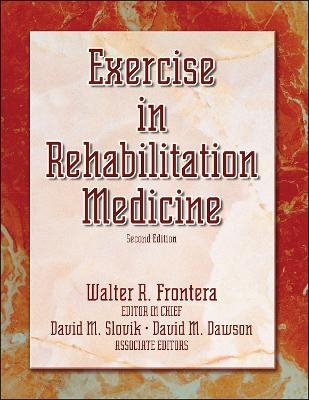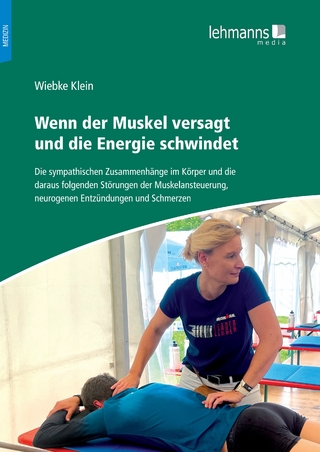
Exercise in Rehabilitation Medicine
Human Kinetics (Verlag)
978-0-7360-5541-3 (ISBN)
- Titel ist leider vergriffen;
keine Neuauflage - Artikel merken
Written by the most distinguished rehabilitation clinicians in the field, Exercise in Rehabilitation Medicine, Second Edition, provides a comprehensive approach to the use of exercise as a primary modality in the arsenal of rehabilitation specialists. Thoroughly updated, this new edition focuses on the basic sciences and clinical correlates affecting the use of exercise, and it includes new chapters on the use of exercise in patients with HIV/AIDS, end-stage renal disease, and cancer recovery. It also includes the following features:
Discussion of equipment and protocols used for testing the capacity of the patient, with specific reference to strength, endurance, flexibility, and balance
12 clinical chapters, each including a case study that shows how the information applies to a specific patient, indicating the practical importance of the knowledge presented
More than 200 tables, illustrations, and photos to reinforce and clarify the text
Subject and citation indexes, along with extensive reference lists for each chapter, making it easy to access the information and explore subjects in greater depth.
In part I, the focus is on biological considerations, including physiological responses to exercise and adaptations regarding strength, endurance, flexibility, balance, and coordination. Only by understanding these basic facts can a health professional properly match a training program with a patient. Part II details special clinical considerations, including the principles of exercise testing and exercise prescription and examining the role of exercise in preventing chronic illness. Part III discusses the rationale and clinical importance of exercise in the rehabilitation of patients with various disabling conditions, and it addresses the factors that must be weighed when prescribing exercise for these conditions. Among the diseases discussed in these 12 chapters are diseases of the heart, circulatory system, lungs, kidneys, joints, and bones and the endocrine, immune, and neuromuscular systems. Part IV includes two chapters on special populations: the elderly and elite athletes with disabilities.
Exercise in Rehabilitation Medicine, Second Edition, combines theory with practical and clinical information, establishing both the “how” and “why” of exercise rehabilitation. Its clarity will help those with little technical expertise to follow it and put it to use, and its detail and advanced material will aid those who are experienced to significantly improve their understanding.
Walter R. Frontera, MD, PhD, is Earle P. and Ida S. Charlton professor and chairman of the department of physical medicine and rehabilitation (PM&R) at Harvard Medical School. He is the chief of PM&R at the Spaulding Rehabilitation Hospital, the Massachusetts General Hospital and the Brigham and Women's Hospital in Boston, Massachusetts. He is board-certified in the medical specialty of PM&R and has a PhD in exercise physiology. He has more than 20 years of experience in the practice of PM&R and in the use of exercise in various patient populations. He is the secretary general of the International Sports Medicine Federation and the editor in chief of the American Journal of Physical Medicine and Rehabilitation. David M. Slovik, MD, is chief of medicine at Spaulding Rehabilitation Hospital in Boston, Massachusetts, where he has worked for 30 years. He has also served as medical director of the musculoskeletal program at Spaulding. Dr. Slovik trained in endocrinology at the Massachusetts General Hospital where he continues to teach and practice. He is an expert on osteoporosis and related disorders, including the effects of exercise on osteoporosis. He is also an associate professor of medicine at Harvard Medical School, with 30 years of teaching experience. He is a member of the American Society of Bone and Mineral Research. David M. Dawson, MD, is professor of neurology at Harvard Medical School and a member of the Department of Neurology at the Brigham and Women's Hospital. He has extensive experience in teaching and in residency supervision and is an expert in clinical neurology with an emphasis on neuromuscular disease and multiple sclerosis. He has served on various boards of the National Multiple Sclerosis Society.
Part I: Biological Considerations
Chapter 1. Acute Physiological Responses to Dynamic Exercise
Roger A. Fielding, PhD; and Jonathan Bean, MD, MS
Cardiorespiratory Response to Dynamic Exercise
Metabolic Response During Dynamic Exercise
Acute Exercise Response in Diabetes Mellitus
Cardiorespiratory Changes With Activity and Inactivity
Physiological Adjustments to Isometric Exercise
Chapter 2. Adaptations to Endurance Exercise Training
Martin D. Hoffman, MD
Physiological Adaptations to Endurance Exercise Training
Psychological Adaptations to Endurance Exercise Training
Factors Affecting Adaptations to Endurance Exercise Training
Simultaneous Strength and Endurance Exercise Training
Chapter 3. Adaptations to Strength Training
Bette Ann Harris, DPT, MS; and Mary P. Watkins, DPT, MS
Anatomical and Physiological Considerations
Functional Biomechanics
Factors Influencing Muscle Strength
Principles of Strength Training
Adaptations to Strength Conditioning
Chapter 4. Training Flexibility
Lisa S. Krivickas, MD
Definition of Flexibility
Factors Influencing Flexibility
Response of Muscle to Stretch
Relationship Between Muscle Stiffness and Flexibility
Measuring and Quantifying Muscle Flexibility and Ligamentous Laxity
Relationship Between Muscle Flexibility and Injury
Relationship Between Ligamentous Laxity and Injury
Effect of Stretching on Delayed Onset Muscle Soreness
Effect of Disease Processes on Flexibility
Relationship Between Flexibility and Athletic Performance
Flexibility and Activities of Daily Living in the Elderly or Disabled
Stretching Techniques and Prescription of a Flexibility Training Program
Effect of Strength Training on Flexibility
Part II: Special Clinical Considerations
Chapter 5. Testing the Capacity to Exercise in Disabled Individuals: Cardiopulmonary and Neuromuscular Models
James C. Agre, MD, PhD
Rationale for Health Screening and Risk Stratification
Rationale for Exercise Testing
Protocols for Exercise Testing, With Examples
Chapter 6. A Behavioral Approach to Prescribing Physical Activity for Health and Fitness
Gregory W. Heath, DHSc, MPH
Preliminary Factors Important for Exercise Prescription
General Exercise Prescription Guidelines
Theories and Models Used in Physical Activity Promotion
Chapter 7. Exercise and the Prevention of Chronic Disabling Illness
Carlos J. Crespo, DrPH, MS, FACSM; and Edith M. Williams, MS
Definitions
Physical Activity and Fitness
Physical Activity and Health
Physical Activity and Prevention of Heart Disease
Exercise and the Prevention of Type 2 Diabetes
Exercise and Primary Prevention of Cancer
Physical Activity and the Prevention of Osteoporosis and Falls
Exercise in the Prevention of Arthritis
Exercise in the Prevention of Low Back Pain
Physical Activity and Primary Prevention of Obesity
Physical Activity and Psychological Well-Being
Part III: Exercise in the Rehabilitation of Specific Diseases and Conditions
Chapter 8. Heart Diseases
Ruy S. Moraes, MD, ScD; and Jorge P. Ribeiro, MD, ScD
Responses and Adaptations of Cardiac Patients to Exercise
Effect of Cardiovascular Drugs on Exercise Responses and Adaptations
Evaluation of Cardiac Patients
Indications for Cardiac Rehabilitation
Contraindications for Cardiac Rehabilitation
Exercise Prescription for the Cardiac Patient
Outcomes of Cardiac Rehabilitation Programs
Chapter 9. Respiratory Disease
Bartolome R. Celli, MD
Physical Reconditioning
Respiratory Muscles and Breathing Training
Chapter 10. Diabetes Mellitus
Edward S. Horton, MD
What Is Diabetes?
Exercise in Type 1 Diabetes
Exercise in Type 2 Diabetes
Chapter 11. Major Inflammatory and Non-Inflammatory Arthritides
Maura Daly Iversen, SD, DPT, MPH; Matthew H. Liang, MD, MPH; and Axel Finckh, MD, MS
Rheumatoid Arthritis
Osteoarthritis
Spondylarthropathies
Systemic Lupus Erythematosus
Polymyositis/Dermatomyositis
Systemic Sclerosis
Improving Patient Adherence
Chapter 12. Neuromuscular Diseases
David D. Kilmer, MD; and Susan Aitkens, MS
Physiologic and Functional Consequences of Neuromuscular Diseases
Causes of Reduced Neuromuscular Function in NMD
Effects of Resistance (Strengthening) Exercise in NMD
Effects of Aerobic (Endurance) Exercise in NMD
Exercise Recommendations in Neuromuscular Disorders
Chapter 13. Spinal Cord Injury
Mark S. Nash, PhD, FACSM
Health Consequences of Spinal Cord Injury
Exercise for Persons With Spinal Cord Injury
Restoration of Function Following Long-Standing Paralysis
Exercise Risks for Persons With Spinal Cord Injury
Medications That May Influence Exercise Performance After Spinal Cord Injury
Chapter 14. Stroke
Joel Stein, MD
Scope of the Problem
Effects of Stroke on Neuromuscular Function
Mechanisms of Motor Recovery Poststroke
Exercise for Motor Control
Strengthening Exercises
Exercise for Ataxia
Exercise for Aerobic Conditioning
Other Benefits of Exercise
Home and Community Based Exercise
Chapter 15. Osteoporosis
David M. Slovik, MD
Mechanical Properties of Bone: Effects of Exercise
Disuse, Weightlessness, and Immobilization
Physical Activity and Bone Mass
Physical Activity, Fall Prevention, and Fractures
Chapter 16. Human Immunodeficiency Virus
Susan D. Driscoll, MPH, MSN, ANP; and Steven Grinspoon, MD
The HIV Pandemic
Exercise to Improve Physical Function in HIV-Infected Patients
Exercise to Improve Psychosocial and Quality of Life Issues in HIV
Exercise Effects on Immune Status and Lactic Acid
Chapter 17. Obesity
Ronenn Roubenoff, MD, MHS
Health Implications of Obesity
Body Composition Through the Life Cycle
Etiology of Obesity
Exercise for Treatment of Obesity
Effect of Exercise on Serum Lipoproteins and Glucose Metabolism
Chapter 18. Cancer
Kerry S. Courneya, PhD; Lee W. Jones, PhD; and John R. Mackey, MD
What Is Cancer?
Epidemiology of Cancer
Medical Treatments for Cancer
Exercise in Cancer Survivors
Exercise Testing and Prescription Guidelines for Cancer Survivors
Exercise Motivation in Cancer Survivors
Future Research Directions
Chapter 19. End-Stage Renal Disease
Pelagia Koufaki, PhD; and Tom Mercer, PhD
What is End-Stage Renal Disease?
Renal Replacement Therapy
Renal Transplantation
Scale and Nature of the Problem
Pathophysiology and Physical Dysfunction in End-Stage Renal Disease
Exercise Rehabilitation Aims
Feasibility and Safety of Exercise Rehabilitation Options in End-Stage Renal Disease
Exercise Prescription in End-Stage Renal Disease
Effectiveness of Exercise Rehabilitation in End-Stage Renal Disease
Part IV: Specific Patient Populations
Chapter 20. Aging, Function, and Exercise
Jonathan F. Bean, MD, MS; and Charles T. Pu, MD
The International Demographics of Aging
A Functional Perspective
Effects of Exercise on Physiologic Aging
Effect of Exercise on Function and Disability
Practical Recommendations
Chapter 21. Elite Athletes With Impairments
Rory A. Cooper, PhD; Michael L. Boninger, MD; Ian Rice, MS, OTR/L; Sean D. Shimada, PhD; and Rosemarie Cooper, MPT, ATP
From Patient to Athlete
Organizational Structure of Sports for People With Disabilities
Sport Equipment Technology and Use
Classification
Exercise Science and the Athlete With Impairments
Training Techniques for Elite Athletes With Disabilities
Injuries Experienced by Athletes With Disabilities
| Verlagsort | Champaign, IL |
|---|---|
| Sprache | englisch |
| Maße | 216 x 279 mm |
| Gewicht | 1315 g |
| Themenwelt | Medizin / Pharmazie ► Medizinische Fachgebiete ► Sportmedizin |
| ISBN-10 | 0-7360-5541-X / 073605541X |
| ISBN-13 | 978-0-7360-5541-3 / 9780736055413 |
| Zustand | Neuware |
| Haben Sie eine Frage zum Produkt? |
aus dem Bereich


